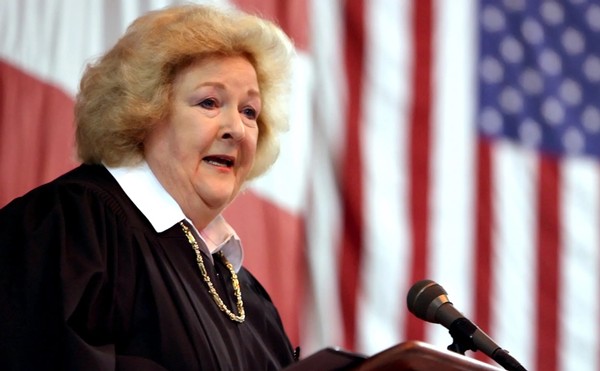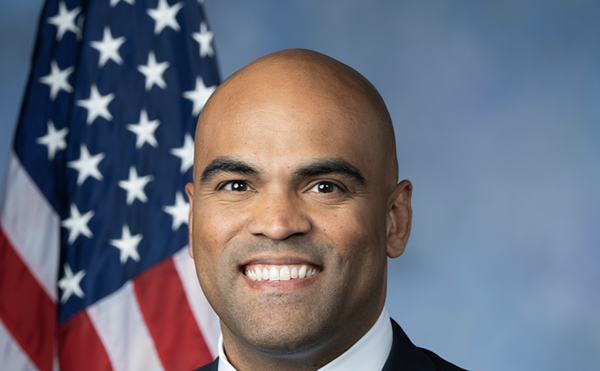You may not believe in destiny, but demography will not be denied. That could be the slogan of Battleground Texas, the organization of Democratic activists who have hitched their wagon to the Lone Star state. Galvanized by President Barack Obama’s decisive sweep of the swing states last November, veteran staffers of that campaign parachuted into Republican redlands earlier this year with the aim of replicating their electoral battleground successes here. The stated mission is to convert demographic change into Democrat dividends, enfranchising and mobilizing the swelling ranks of majority-minority voters in the state, millions of inactive Latino voters in particular.
As the heft of the traditional Republican base dwindles, this partisan switcheroo has become not a question of if, but of when. And when it happens, the GOP can kiss the White House goodbye for at least a generation. The ambitious BGTX endgame contemplates the capture of the state’s 38 presidential electoral votes, securing victory in races for the Oval Office in the foreseeable future.
Skeptics respond that even if rock-bottom voter participation rates among Latinos rise, their demographics don’t support a flip in the state until the 2024 or 2028 presidential cycles. Republican strategists see that time window as critical, sufficient enough to erode Hispanic support for the Democratic party and avert the end of their two-decade dominance of state politics. Nobody knows how wide that window is, but even BGTX has sought to tamp down expectations of near-term results. “If 2020 is the year we turn this state blue, that’s OK with me,” BGTX Executive Director Jenn Brown told a recent Austin recruitment rally.
However, there is nothing fuzzy about the math. The Democrats can take Texas in 2016 if they can tap into one a key segment: white Texans, and in particular white women, the new kingmakers–or queenmakers–of Lone Star politics.
Why? Women of color broadly support Democratic candidates, but that’s just the point: BGTX needs to mine new veins of voters. At least at this stage, minority population trends alone will not lock up the race, since heavily Republican non-Hispanic whites will still hold a slim majority through the next presidential cycle. Even if Battleground succeeds in ramping up meager Hispanic voter turnout to white levels, a Republican candidate would likely still prevail in 2016.
“I think [Texas Battleground] realizes that it’s not just a matter of finding and turning out minority voters,” says Ruy Teixeira, co-author of the book The Emerging Democratic Majority and a senior fellow at Center for American Progress. “It’s also a matter of finding and turning out relatively liberal white voters, given the structure of the Texas electorate and given how conservatively white voters have been voting. The treasure trove would presumably be more likely to be college educated, more likely to be younger, and more likely to be women living in the big metropolitan areas.”
Minority Rapport
Two centuries ago French philosopher Joseph de Maistre wrote, “Every nation has the government it deserves,” a phrase deployed many times since to evoke the concept of popular sovereignty. So what did Texans do to deserve culture warrior Rick Perry with his unyielding co-partisan supermajority in the Lege?
How about, “failed to exercise the right to vote.” Gov. Rick Perry was elected by just 18 percent of the citizen voting-age population (CVAP) as measured by the U.S. Census Bureau. Texas recorded the lowest turnout rate in the nation for the 2010 midterms, when Perry won re-election. As the vast majority of the state abstained, activist voters flocked to the ballot boxes, the face of the base in Republican Texas: older, largely rural, evangelical whites. Most elected officials at the state level owe their offices to the same narrow constituency.
Make no mistake: Texans stand among the conservative crowd, but, unlike their government, squarely in a moderate vein. According to last month’s University of Texas at Austin/Texas Tribune Texas Politics Poll, a relative majority of registered voters self-identify as moderate, with an absolute majority describing themselves as moderate or moderate with a liberal or conservative leaning; only one-third label themselves somewhat or very conservative.
The same poll reveals a majority of support for background checks on all gun purchases, including gun shows and private sales, the right to same-sex marriage, access to legal abortion, boosting funding for public education, and comprehensive immigration reform. Yet time and again Perry and like-minded lawmakers soften gun laws, denounce gay unions, and shortchange education and healthcare. (Though this topic was not in the most recent UT/TT poll, other surveys such as the Lyceum indicated most Texans favored accepting the Medicaid expansion, rejected by the state for an estimated loss of $100 billion in federal health care funds.)
“The folks in Austin and in Washington D.C. who are claiming to speak on the behalf of Texans, (a) they don’t sound like most of the Texans I’ve met; they’re far outside of the mainstream with their extremist rhetoric,” says Alex Steele, statewide field director for BGTX. “And (b) they don’t look like Texans.”
According to the National Conference of State Legislatures, the Texas Capitol is 78 percent Caucasian and 80 percent male. One need not compare census data to know these proportions are unrepresentative. But let’s compare anyway. The Census Bureau reports the state at 45 percent non-Hispanic white and 50 percent male.
De Maistre, a fervent proponent of elite power and the divine Christian origin of political constitutions, would probably approve.
People Parsing
BGTX is fond of pointing out that Texas, of four minority-majority states (five including Washington D.C.), is the only one still in the red, politics-wise. Whites now make up 45 percent of the population; Hispanics are at 38 percent; African-Americans just more than 12 percent; and Asian-Americans, Native Americans, and others share the remaining 5 percent. Whites account for just over 50 percent of the CVAP, and that is slipping fast into minority territory, too.
Teasing electoral trends from demographic data requires juggling dozens of variables culled from imperfect raw numbers. Strategizing around those trends amounts to calling out audibles from a political vacuum. Simulating results for 2016 is like predicting a horse race without knowing the horses or track conditions.
Most observers tend to respond by simplifying. Consider, for example, an April 11 article by BusinessWeek entitled, “Texas, Election Battleground: Democrats Aim to Mobilize the Hispanic Vote.” The author concludes by saying: “The bottom line: In 2012, 2.2 million Texas Hispanics who were eligible to vote didn’t cast a ballot. If half had voted for Obama, he would have won the state.”
Actually, Republican candidate Mitt Romney corralled his 38 Texas electoral college votes by a hefty margin of 1,261,719 ballots, according to Texas Secretary of State records. All other demographic variables being the same, half of 2.2 million voting for President Barack Obama would not, in fact, have overcome that deficit.
But more importantly, it is fallacious to assume that if all 2.2 million additional eligible Latinos had hit the voting booths during last November’s presidential contest, the entirety of them would have opted to reelect the incumbent Dem. Nationally, Latinos favored Obama 71 percent to 27 percent. If that same blue bias held true in Texas during a hypothetical full-count Hispanic turnout, Romney still would have cleared the popular tally in the Lone Star by almost 300,000 votes.
As an additional wrinkle, however, Texan Latinos hover a bit more to the right than they do nationally. Exit polls by the National Election Pool were not conducted in Texas in 2012, but in the previous presidential contest, Latinos here voted for Obama over then-contender John McCain by a 63-percent-to-35-percent margin. If the same support levels in 2008 repeated in 2012, Romney would have outstripped Obama by 646,000 votes, even with a full house of 2.2 million additional Latinos hitting the polling stations.
This effect is so profound that, if the 2008 proportion held true in 2012, in excess of 4.5 million additional Latino voters would have needed to cast ballots before tipping the scales toward the Democratic candidate. So it’s not half of eligible non-voting Latinos to cover the spread. It’s actually more than double. And it’s more than the total number of eligible Latino voters in Texas that year.
Fast forward through eight years of demographic change and the figures converge much closer to a tipping point by 2016. Utilizing 2008 Texas exit polls (not available for the state in 2012) crossed with U.S. Census Bureau voter turnout figures from 2012, and applying those ratios to a projection of the number of 2016 eligible voters by ethnicity as calculated by the Center for American Progress yields a Republican victory in in the next contest.
Even under an assumption that Battleground Texas successfully mobilizes target voters, elevating Hispanic and other minority turnout to levels achieved by whites last year (which is actually a slight decrease for African-Americans, the group posting the highest 2012 turnout rate), the state retains its crimson hue by a five-point 52-47 margin. However, given those same parameters, tweaking up Democratic support by white women from 28 percent (from 2008 exit polls) to, say, a lowly 35 percent, blues the result.
That’s why, in order to accelerate the demographic slide into blue territory, the Democrats will have to both peel off white support from the Republicans and mobilize whites who currently do not vote—in part because of the perception of futility of voting Dem in Texas. Fortunately for BGTX, the hard swerve to the right by the current Republican Party has left the political center wide open for recruitment of moderate white voters, all the more so for females incensed by the recent Republican-led restrictions on their reproductive rights.
Secret Code
Whereas voter turnout declined nationally in the 2012 presidential election versus the 2008 contest, it rose marginally in the nine swing states. Out of those states, the Obama For America campaign organization pocketed eight. Tactically, it was one of the most effective executions of a ground game in any U.S. election. Led by former national field director for that campaign, Battleground Texas employs the OFA handbook: traditional grassroots organizing backed by a full-court press on the digital side.
In most places local chapters of the Democratic Party share infrastructure. The Bexar County Democratic Party appointed Precinct Chair Emil Hunziker as the BGTX liaison, and also set aside office space for such operational needs as phone-banking. The BCDP, while continuing to retain its own grassroots capability, offers local logistical support and plugged BGTX into the local network of Democratic Party clubs.
Out of Austin, a lean BGTX managerial team recruits “fellows” who pledge a certain number of hours per week and attend a boot camp. Each fellow coordinates a team of regular volunteers back in their neighborhood. In the organization’s first four months, it recruited and trained over 2,500 deputy voter registrars across the state and 200 summer fellows all across Texas, with over a dozen in San Antonio. Following the OFA “snowflake” model, these volunteers participate in voter registration drives at events, through phone banks and by door-to-door canvassing. Voter registration is dual purpose: It elevates the number of registered voters, and information on the voter-registration card is harvested for a master database.
It’s too early to know what kind of impact the fieldwork is having, but voter registration is climbing steeply. More than 800,000 new Texas voters registered in the eight-month period stretching from the last presidential elections through the end of June, a whopping 64-percent increase from the comparable period after the previous vote, according to data from the Texas Secretary of State.
On the cyber side, BGTX works the same digital formula developed for the Obama 2012 campaign: sophisticated data mining techniques, micro-targeting strategies and massive usage of social media and email. Facebook landing pages, Tweet barrages and a steady stream of finely tuned email messages sweep up new volunteers and, especially, sponge up donations. In the first four months of operation, the BGTX Web page had rung up more than $1 million via donations, or 96 percent of the total take of $1.1 million. Seventy-nine percent of donations came from inside Texas and the median donation size of more than 3,500 payments was $25.
It has been widely publicized that, following his reelection, the president and his campaign staff refused to release details of the digital campaign architecture, preserving the code and engineering schematics under lock and key to be lent or leased to a few select organizations. Presumably, the OFA veterans now with BGTX have access to at least part of the same powerful programming code developed by dream-team software engineers for the 2012 Obama campaign. Battleground Texas won’t comment, saying, “we don’t get into the specifics of our data program,” but the platform looks to be running on very similar infrastructure.
Red Herrings
For years GOP strategists have publicly fretted over the consolidation of the expanding population of Latino voters as part of the Democratic coalition. Obama’s capture of both popular and electoral vote majorities last November despite ceding a crushing majority of white votes for Romney underscored the urgency of broadening the party’s appeal. But the party suffers from so much disarray and internecine power struggles at the moment that it has done more to alienate Latinos, and, for that matter, women, than to build bridges. Most recently, the GOP-led U.S. House of Representatives rebuffed the bipartisan immigration reform bill, which Texan Latinos name as a top policy priority. Even before breaking up on the shores of the lower House, both Texas Republican senators John Cornyn and Ted Cruz had already voted against it.
It can be hard to take seriously the steady issuance of resolutions by the Republican Party of Texas to embrace minority politics and policies. A recently issued memo on the group’s Web site reads: “We will also be adding a significant number of field staff to be embedded in the Hispanic, African-American and Asian-American communities around Texas.”
Embedded sounds so... creepy? Yet BGTX volunteers just scratch their heads when asked if they see GOP counterparts canvassing at public events. Activists are nowhere to be found. “They’re probably at the golf clubs and the banquets,” quips the BCDP’s Emil Hunziker. “The Republican Party doesn’t have any idea how to do a ground game.”
In June, Politico published an internal document from the Koch-funded group FreedomWorks directing $8 million toward Texas to “counter state and national Democratic efforts to make the state more electorally competitive.” The budget includes $1.8 million for public opinion polls, $1.6 million for online media advertising, and hundreds of thousands of dollars for Facebook, Twitter and email outreach. The fact that such an enormous outlay is required to teach the GOP how to network the virtual grassroots only reveals just how far behind the Democratic machine it lags: BGTX’s Facebook followers outpaced the Republican Party of Texas profile in just 78 days and now has an online reach of 8 million.
Get The Gringa
“There is also great potential to engage women voters in Texas,” BGTX head Jeremy Bird wrote in a blog in February. “Women voters in the Lone Star state supported Obama by just 47 percent in 2008–far fewer than the 55 percent nationwide that supported the president in both 2008 and 2012.” In both cases, the spread over men exceeded 10 points. More women turned out to vote than men, as well, 64 percent of the female CVAP, versus 60 percent for men.
In the toughest battleground states of 2012, women cast the decisive votes. Even though male voters in Ohio had backed Obama in 2008 with a narrow 51-48 percent margin, they swung red last year, voting 52 percent in favor of Romney. But Obama raised support among Buckeye women voters to 55 percent last year from 53 percent in 2008, and the crucial state ended up in his column. Floridian men also switched camps with a five-point jump in Republican voting to 52 percent. But again more women turned out for the Democrats, tipping those 29 electoral votes toward the incumbent. Floridian women outvoted men by 650,000 ballots; Florida was decided by fewer than 75,000 votes.
In Texas, white women favored McCain and Romney by wide margins, though not as lopsidedly as did men. White women, accounting for one-third of the total vote in 2008, voted McCain by a 72-28 margin, whereas their male counterparts favored the Republican slightly more, by 75-25. (Again, 2012 exit polls are not available for Texas.) Battleground Texas sees the disparity between national voting patterns and those in Texas as evidence of a dormant female Democratic vote here—one that might have just erupted this summer.
State Sen. Wendy Davis’ viral filibuster in June of a bill to impose draconian restrictions on abortion providers in Texas may have ultimately failed, but the attempt vaulted her into the limelight. In the process, the Lege’s abortion battles illuminated not only on the Ft. Worth lawmaker, but exposed cavalier treatment by the GOP supermajority of Davis, her female colleagues and women’s issues generally. Republicans passed their bill, but the blowback served as a feminist call to arms.
“I stood up to filibuster the bill because Texas Republican leaders would rather pursue a partisan agenda than help Texas women,” Davis wrote in a Washington Post op-ed. “The people’s filibuster demonstrated that Texans—and women everywhere—are ready and willing to fight back.” In the weeks that followed, donors poured nearly $1 million into her campaign, positioning her for a gubernatorial run in 2014. Members of Battleground Texas, which rolled out a “/stand-with-wendy” donations webpage before the filibuster concluded, tweeted furiously throughout the legislative showdown. At a voter registration drive coinciding with the women’s rights filibuster and rally at the Capitol on July 1, BGTX registered five times as many voters as they had in past field days.
The synergies are compelling. If Davis runs, BGTX will bring to bear the force of its digital and grassroots campaign blitzkrieg in her support. Winning the governor’s mansion on a Democratic ticket remains a distant longshot in 2014, both because it comes so early in the BGTX push to organize a viable Democratic voter base, and because turnout is even lower for gubernatorial races than for presidential contests. (The lower the turnout, the lower the Dems’ odds at the ballot box.) But a strong run could cement her national stature.
Whether Davis wins or loses, Battleground wins: Democratic voters are mobilized. Meanwhile BGTX founder Bird joined the “Ready for Hillary” superPAC to back Hillary Clinton to run for president in 2016. Houston trial lawyers Steve and Amber Mostyn, who gave a $250,000 dollars to BGTX in the first half of 2012, helped found Ready for Hillary.
And whether Clinton wins or loses Texas, Battleground still wins: In its first months it has proven capable of organizing its digital and field strategy rapidly, of raising millions of dollars and of connecting with issues that matter not just to progressive Texans, but also to moderates increasingly estranged from the radical conservatives dominating the state GOP.
In the improbable event that the Republicans finally respond effectively to the challenge, demography might not lock up Texas for the Democrats for several more presidential cycles. But GOP candidates will now have to expend huge resources and effort to secure a terrain once considered conquered: Exactly the battleground Democrats are fighting for now.

















